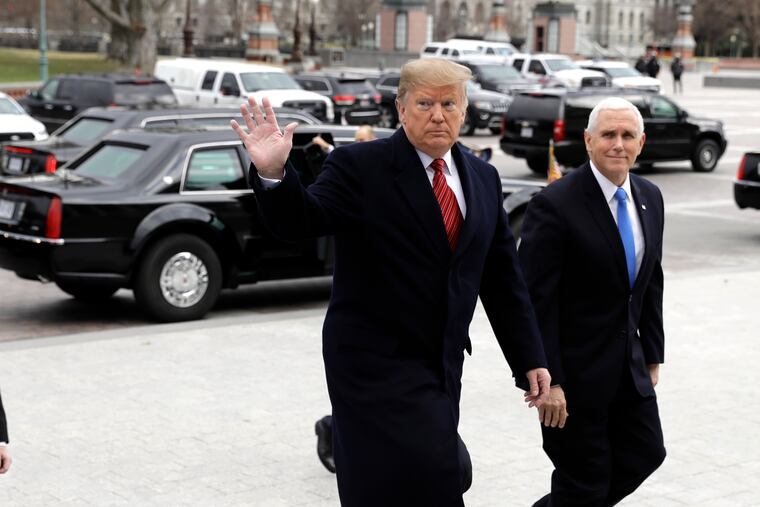Defeating AIDS in 10 years is possible, just not for the Trump-Pence administration | Opinion
The people who are most harmed by the Trump administration are the people most impacted by HIV.

During the State of the Union address, between statements on hot-button issues such as immigration and abortion, President Donald Trump proclaimed: “Together, we will defeat AIDS in America. ... My budget will ask Democrats and Republicans to make the needed commitment to eliminate the HIV epidemic in the United States within 10 years.”
Ending HIV transmission in 10 years is an achievable goal. However, a closer look at Trump’s overall agenda, as well as the members of the administration who are likely to lead the effort, makes experts skeptical that the effort will fail.
According to the Centers for Disease Control and Prevention, about 1.1 million people were living with HIV in the United States at the end of 2015. That number has likely grown in recent years as injection drug use has increased. In 2016, according to the Philadelphia Department of Public Health, the city had the highest rate of new infections compared with other large cities. Both in Philadelphia and nationally, black men who have sex with men or inject drugs are at the highest risk.
Though Trump did not provide details about his plan, looking at the response to an HIV outbreak in Indiana while Vice President Mike Pence was governor could provide clues to what might come.
Starting in 2014, Scott County, Ind., went through an HIV outbreak that by 2015 led to 215 new cases. Gregg Gonsalves, a professor at the Yale School of Public Health and a former AIDS activist, studied the response to the outbreak. According to Gonsalves, a prelude to the outbreak was a 2013 decision by Pence to cut public funding to Planned Parenthood in Indiana, forcing the only HIV testing provider in Scott County to shut down. During the time, Indiana’s health commissioner was Jerome Adams, who is serving as Trump’s surgeon general.
It took Pence and Adams months after the first reports of the cluster of patients to respond to the outbreak. Eventually, Pence allowed a temporary syringe exchange program that received no public funding.
Gonsalves and his Yale colleague Forrest Crawford wanted to see what would have happened if Pence and Adams had acted earlier. Using epidemiological modeling, they found that if instead of closing the Planned Parenthood in 2013, Pence had increased funding for testing, only 56 or fewer people would have been infected in total. “Just testing and diagnosis alone would have severely blunted the epidemic.” Gonsalves explained that opening a syringe exchange program would have reduced the number of infections even more.
The lesson from Indiana is simple. HIV infections do not happen in a vacuum. Pence’s anti-choice zeal and War on Drugs mentality, which led to shutting down Planned Parenthood and the criminalization of syringe exchanges, exacerbated the crisis.
What this shows us is that the Trump administration’s positions on drug laws, health care, education, and reproductive rights all stand as barriers to an effort to defeat HIV/AIDS.
Take health care. “The first thing to do to prevent HIV infection is to make sure that anybody who has an HIV infection can’t transmit, and the way to do that is to make sure that they’re on treatment,” Gonsalves said. Many people who live with HIV depend on Medicaid. And yet, the Trump administration allowed states — including Indiana — to impose work requirements on Medicaid, risking thousands losing insurance in a time of need.
HIV is also a preexisting condition — protected under the Affordable Care Act, which the Trump administration is intent to repeal. Any action that contracts health insurance coverage instead of expands it adds fuel to the next HIV outbreak.
And then there is the War on Drugs. It is still up to states whether they allow syringe exchanges — even though they are proven to be effective in reducing HIV transmission without increasing drug use, according to the National Institute on Drug Abuse. In most states, syringe exchange programs are not explicitly authorized under the law. There is also a ban on federal dollars for syringes and needles.
But the most obvious clue that the Trump administration’s effort to fight HIV could likely fail is the overlap between the people who are harmed by the Trump administration and the people most impacted by HIV.
“HIV still targets gay men and people who use drugs,” Gonsalves said in pointing out Pence’s past support of conversation therapy and Trump’s attacks on the rights of transgender people. “If you are going to try to develop a health response to a community that you revile, despise, and try to destroy through conversation therapy, you are probably heading again in the wrong direction — the same with substance use.”
HIV harms the most marginalized people in America — people in addiction, sex workers, gay men, transgender people, and mostly people of color. A fight against HIV/AIDS is a fight for the lives of these people. Will Trump and Pence believe those people are worth fighting for?